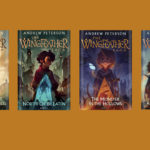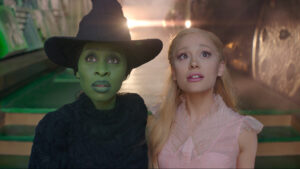For decades now, Andrew Peterson has combined the rare ability to write moving music that is at once thoroughly steeped in Scripture, personally honest with the weakness and sin that plague us all, and in awe of the gift we have in Christ. I can’t listen to Peterson’s music and not be freshly amazed that Jesus loves me—that even amid suffering, doubt, and sin, I’m part of a redeemed people who belong to him by faith, and he we will bring us home. If you’re unfamiliar with Peterson’s music, just take a listen to “Is He Worthy?” to get a sense of this:
Does the Father truly love us? (He does)
Does the Spirit move among us? (He does)
And does Jesus, our Messiah hold forever those he loves? (He does)
Does our God intend to dwell again with us? (He does)
This year marks the 20th anniversary of the Behold the Lamb of God tour—where the redemptive storyline of Scripture, from the promise of a deliverer to the coming of Jesus, is set to music. Trevin Wax calls it Peterson’s “masterpiece,” which isn’t exaggeration, since for 20 years now thousands of people have made the concert tour part of their Advent ritual. And to mark this anniversary, Peterson will release a new recording of Behold the Lamb of God on October 25.
In Peterson’s newest and first non-fiction book, Adorning the Dark: Thoughts on Community, Calling, and the Mystery of Making (B&H), he reflects on his life making music, the community that has nourished art, the nuts and bolts of writing, and more. In this memoir of sorts, we see Peterson at his vulnerable best—honest with his shortcomings and anchored to the good news that the gospel of Christ is really true.
I corresponded with Peterson about how we’re all creative, the most helpful writing advice he’s received, what he wishes every Christian knew about artists, how the annual Behold of Lamb of God tour has affected him, and more.
You argue that every Christian is a creative, not just those who make music and art. For the Christian who doesn’t view him or herself as a creative, why do you stress this point so much? What difference does it make?
Well, for starters, I don’t like calling anyone “a creative”—but yes, I believe everyone is creative. It makes a difference, since that language implies there’s a special class of person who’s somehow more creative than everyone else. That’s just not true. Mathematicians are profoundly creative, as are architects and pastors and homemakers. It’s just not helpful to draw that line. Yes, there are artists, but as my friend Jonathan Rogers says, the arts only make up one slice of the pie of human creativity—and not the most important slice, either.
What if a pastor thought of his sermon writing through the lens of creativity? What if whoever cooks at home for the family considered Tuesday night dinner an expression of his or her God-given, Spirit-led creative life? There’s something highfalutin about referring to oneself as “a creative,” and I’d be fine if we stopped doing that altogether. We sometimes refer to the annual Rabbit Room conference as “a conference for everyone.” Part of the point is to remind people of that soul-deep impulse we all have, as image-bearers, to make the world around us more beautiful.
You write that “community—especially Christ-centered community—nourishes art and art nourishes community.” How have you seen this at work in your life?
When I moved to Nashville 20 years ago, I had no idea what I was in for. I hoped I would grow as a songwriter. What I didn’t foresee was the community that sprang up around those of us fighting to follow our vocations. I looked around a few years after we moved here and realized that I had made lifelong friends, co-laborers for Christ, and those friendships far outshone whatever artistic augmentation I experienced. But the cool thing was that, on the other side of the coin, being a part of a community really did make us all better at the craft.
So there’s a symbiotic relationship between community and art. The fact that it was a Christian community brought a kingdom-hearted flourishing to both.
There’s a symbiotic relationship between community and art. The fact that it was a Christian community brought a kingdom-hearted flourishing to both.
What’s the most helpful advice on writing you’ve received? And what’s the most common advice you give?
The most freeing thing I ever read was in Anne Lamott’s Bird by Bird. When I encountered her chapter on writing bad first drafts, the realization that the work always starts bad and is then improved, shaped into something better by the small community of editors, proofreaders, and friends, was tremendously helpful.
What I usually tell people is similar: Just get busy writing. The only way to learn to write is to write.
You call honesty, truth, and beauty the “trifecta of good Christian art.” How so?
This idea came from trying to understand what it was about Rich Mullins’s best songs that moved me so. They were honest and earthy, and when he sang, I believed him. But they were also crafted with excellence, and it was clear he had a rare genius for poetry. In addition to his honesty and craftsmanship, because he knew and employed Scripture, his songs carried the weight of truth; they weren’t just his ideas—his songs were dripping with Scripture. If you remove just one of those three ingredients, you get something different.
For example, if you have art that’s honest and true, but isn’t beautiful or well-crafted, you get a lot of mediocre Christian art (we all know what I’m talking about).
If you have art that’s honest and beautiful, but isn’t necessarily biblical, you end up with a lot of mainstream art (and to be clear, I’m not saying there’s not plenty of truth in that kind of art—I’m only saying it wouldn’t be defined as “Christian,” because it isn’t articulating the gospel in the way, say, a hymn might).
And finally, if you had art that was beautifully crafted and dripping with Scripture, you’d have hymns. Hymns can be great, but it’s the ones that crack open the heart because of the vulnerability of the writer that I think are the most effective. I think of the line “Prone to wander, Lord, I feel it / prone to leave the God I love” as a prime example. The hymn writer got down to the marrow with that line, and it took some guts to write it. This rule isn’t hard and fast, but it at least describes the kind of art that has moved and edified me the most.
What do you wish every Christian knew about artists? And how can the church serve artists in our midst?
Artists aren’t any better than anybody else. I wouldn’t want to tip the scales so that the arts were held to be somehow more important than any other gift a Christian brings to their community. But if it’s true that heaven and earth are full of God’s glory, then it’s good and proper that we support those in the church who give us new eyes to see that glory brimming over in every corner of creation.
The church is the garden where all our gifts grow best.
I hope the local church is always looking for ways to welcome the gifting of every member—even the ones like me who happen to geek out over movies and novels and poetry. I remember Eugene Peterson saying he thinks writers and poets should be commissioned and sent by churches. I don’t know how all that works, but it would be nice if the church found a way, for example, to keep her traveling musicians in their prayers, to integrate the artisans’ work into the weekly service, to show the novelists that they’re seen and supported. But I want to reiterate that you could say the same for the architects and doctors and teachers. The church, as I’ve said, is the garden where all our gifts grow best.
This year marks the 20th anniversary of the Behold the Lamb of God tour, which focuses on the story of the coming Christ and the salvation he offers. You’ve said elsewhere, “There is no story I’d rather be true, no story I’d rather tell.” Twenty years now later, how has this annual artistic ritual affected you? And what’s your goal for those attending one of the shows?
Every Moment Holy, Douglas McKelvey’s wonderful book of liturgies for everyday moments, includes “A Liturgy Before Taking the Stage.” We pray it on that tour almost every night. One of my favorite parts of the prayer says, “Let these humble elements, in your hands, become a true nourishment for those who hunger for you. And for those who have not yet wakened to their deepest hungers, let this brief service to them be like the opening of a window through which the breezes of a far country might blow, stirring eternal longings to life.” That’s my best hope for both Behold the Lamb of God (at Christmas) and Resurrection Letters (at Easter): that the songs would awaken a longing in those who don’t yet know Jesus, and that it would pique the longing in those who do.
“The Most Practical and Engaging Book on Christian Living Apart from the Bible”
 “If you’re going to read just one book on Christian living and how the gospel can be applied in your life, let this be your book.”—Elisa dos Santos, Amazon reviewer.
“If you’re going to read just one book on Christian living and how the gospel can be applied in your life, let this be your book.”—Elisa dos Santos, Amazon reviewer.
In this book, seasoned church planter Jeff Vanderstelt argues that you need to become “gospel fluent”—to think about your life through the truth of the gospel and rehearse it to yourself and others.
We’re delighted to offer the Gospel Fluency: Speaking the Truths of Jesus into the Everyday Stuff of Life ebook (Crossway) to you for FREE today. Click this link to get instant access to a resource that will help you apply the gospel more confidently to every area of your life.





































